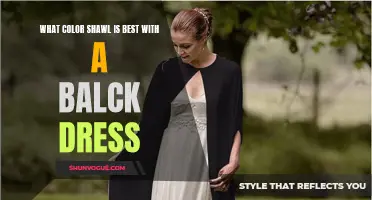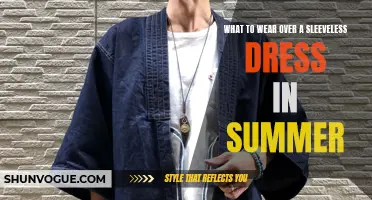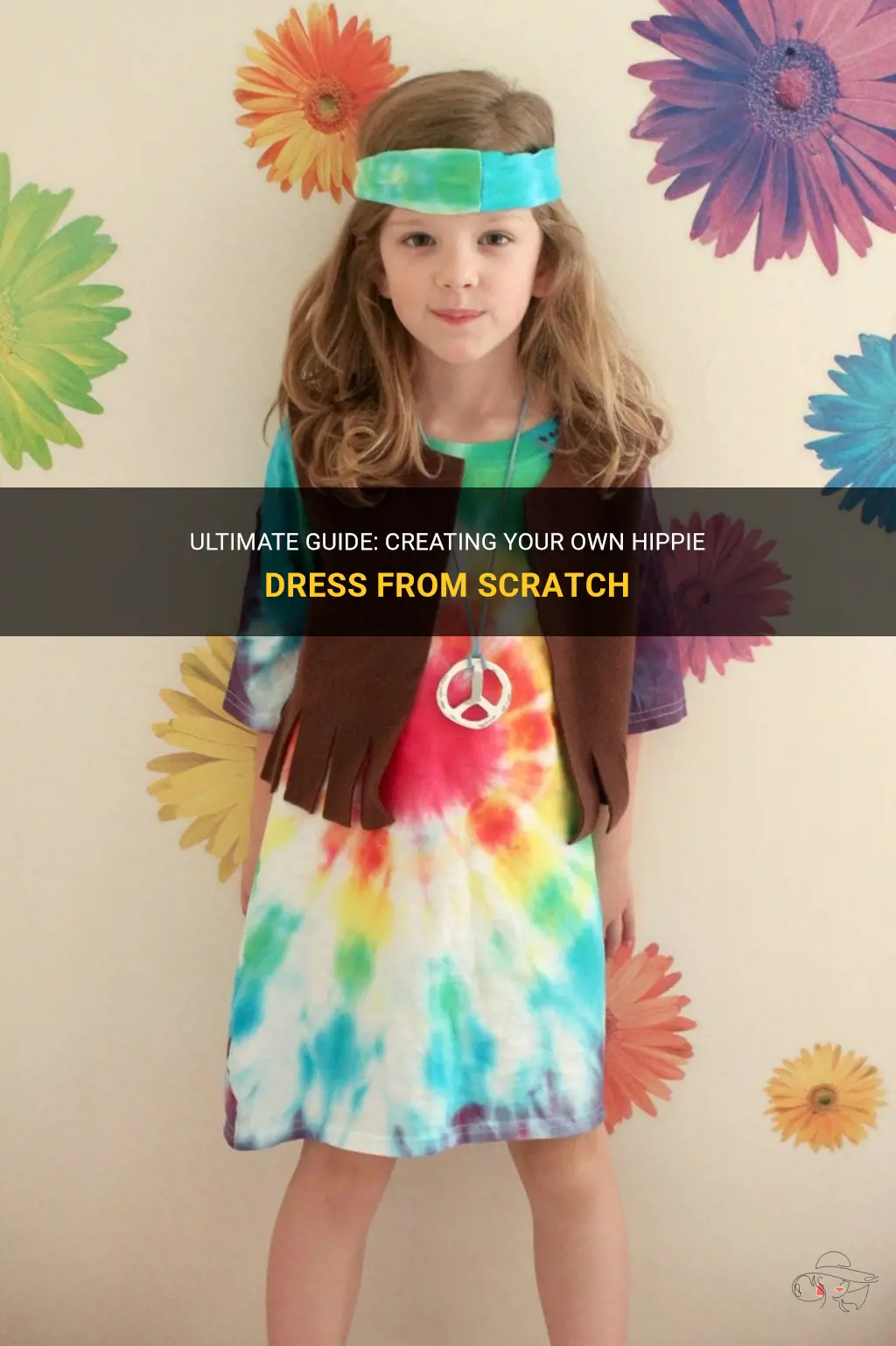
Are you tired of the same old mainstream fashion trends? Looking for a unique and creative outfit that reflects your free-spirited personality? Well, look no further! In today's guide, we will show you how to make your very own hippie dress, a symbol of rebellion, individuality, and peace. Whether you're attending a music festival or simply want to embrace your bohemian side, this DIY project will have you turning heads and spreading positive vibes wherever you go. So grab your sewing kit and get ready to unleash your inner flower child, as we dive into the wonderful world of hippie fashion!
| Characteristics | Values |
|---|---|
| Fabric | Cotton |
| Colors | Vibrant |
| Length | Maxi |
| Sleeves | Flutter |
| Pattern | Floral |
| Neckline | Boat |
| Fit | Loose |
| Decoration | Tassels |
| Accessories | Beads |
| Layering | Yes |
What You'll Learn
- What are the key elements needed to make a hippie dress?
- What type of fabric should be used for a hippie dress?
- Are there any specific patterns or designs that work well for a hippie dress?
- What are some techniques or sewing skills required to make a hippie dress?
- Can you provide a step-by-step guide on how to make a hippie dress from scratch?

What are the key elements needed to make a hippie dress?
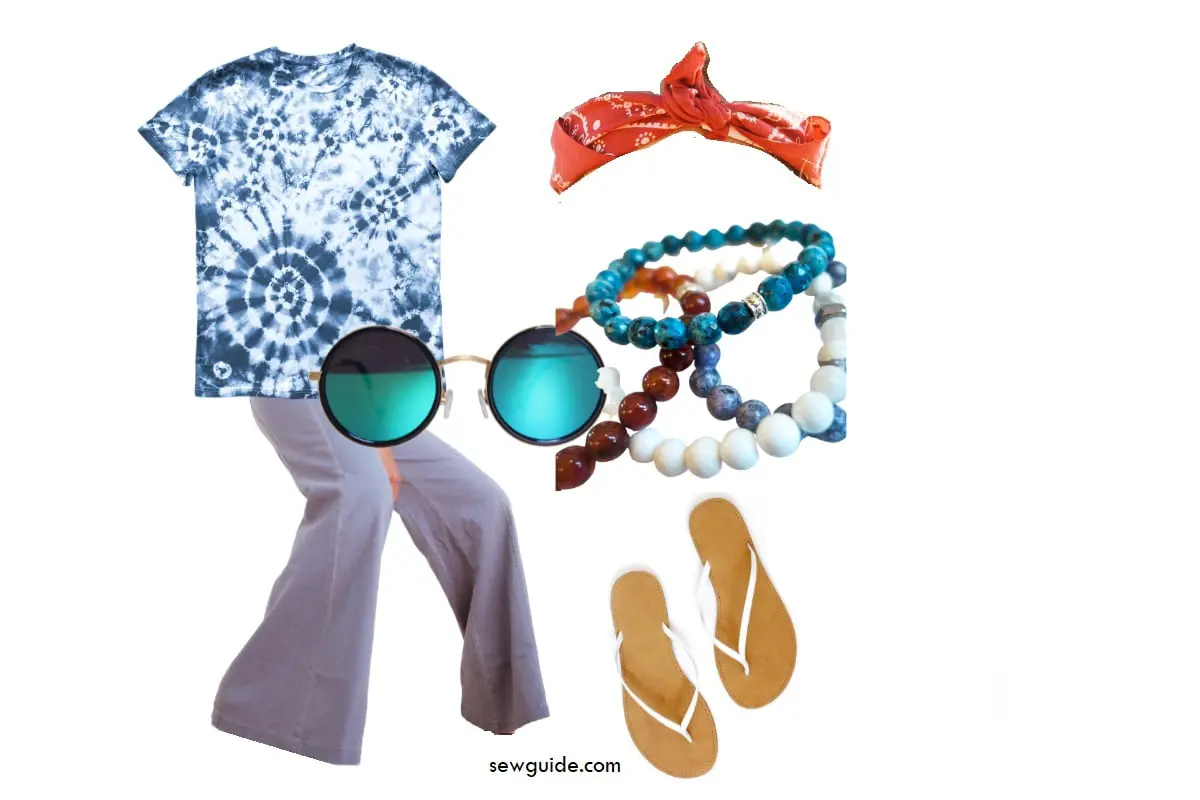
Hippie dresses are known for their free-spirited and bohemian style. They are often associated with the counterculture movements of the 1960s and 1970s and have made a comeback in recent years. If you're interested in making your own hippie dress, there are several key elements to consider.
- Fabric: The fabric you choose for your hippie dress is crucial in capturing the bohemian vibe. Opt for flowing and lightweight materials such as chiffon, silk, or cotton. Look for prints inspired by nature, like floral or paisley, or go for bold and colorful patterns. Keep in mind that natural and earthy tones work well for a more authentic look.
- Silhouette: Hippie dresses are often loose and relaxed, with a focus on comfort. The silhouette should be free-flowing and airy, letting the fabric move with you. Empire waistlines, A-line cuts, and maxi lengths are common in hippie dress designs.
- Details: Pay attention to the details to enhance the bohemian style of your dress. Add fringe or lace trim along the hemline or sleeves for a whimsical touch. Consider incorporating crochet elements or embroidery for a more handmade feel. Don't shy away from accessories like tassels or beads to add a touch of boho flair.
- Neckline and sleeves: Hippie dresses often feature unique necklines, such as off-the-shoulder, deep V-neck, or halter styles. These options give a more romantic and ethereal look. When it comes to sleeves, consider bell sleeves or puffed sleeves for a retro feel.
- Embellishments: Another element that can enhance the hippie aesthetic of your dress is the use of embellishments. Appliques, sequins, and beads can be added to create a one-of-a-kind look. Experiment with textile techniques like tie-dye or batik for a more psychedelic vibe.
Additionally, keep in mind that the key to a successful DIY hippie dress lies in the personalization and creativity you bring to the project. Take inspiration from iconic hippie fashion icons like Janis Joplin, Stevie Nicks, or Woodstock-era fashion. Play with different combinations of fabrics, colors, and patterns to create a dress that truly reflects your style and personality.
In conclusion, making a hippie dress involves choosing the right fabric, silhouette, details, neckline, sleeves, and embellishments. By incorporating these key elements, you can create a dress that exudes the free-spirited and bohemian vibe that is characteristic of the hippie fashion movement. So grab your sewing machine, unleash your creativity, and get ready to embrace your inner flower child in your handmade hippie dress.
Understanding Anahi's Dress Size: A Guide to Finding the Perfect Fit
You may want to see also

What type of fabric should be used for a hippie dress?
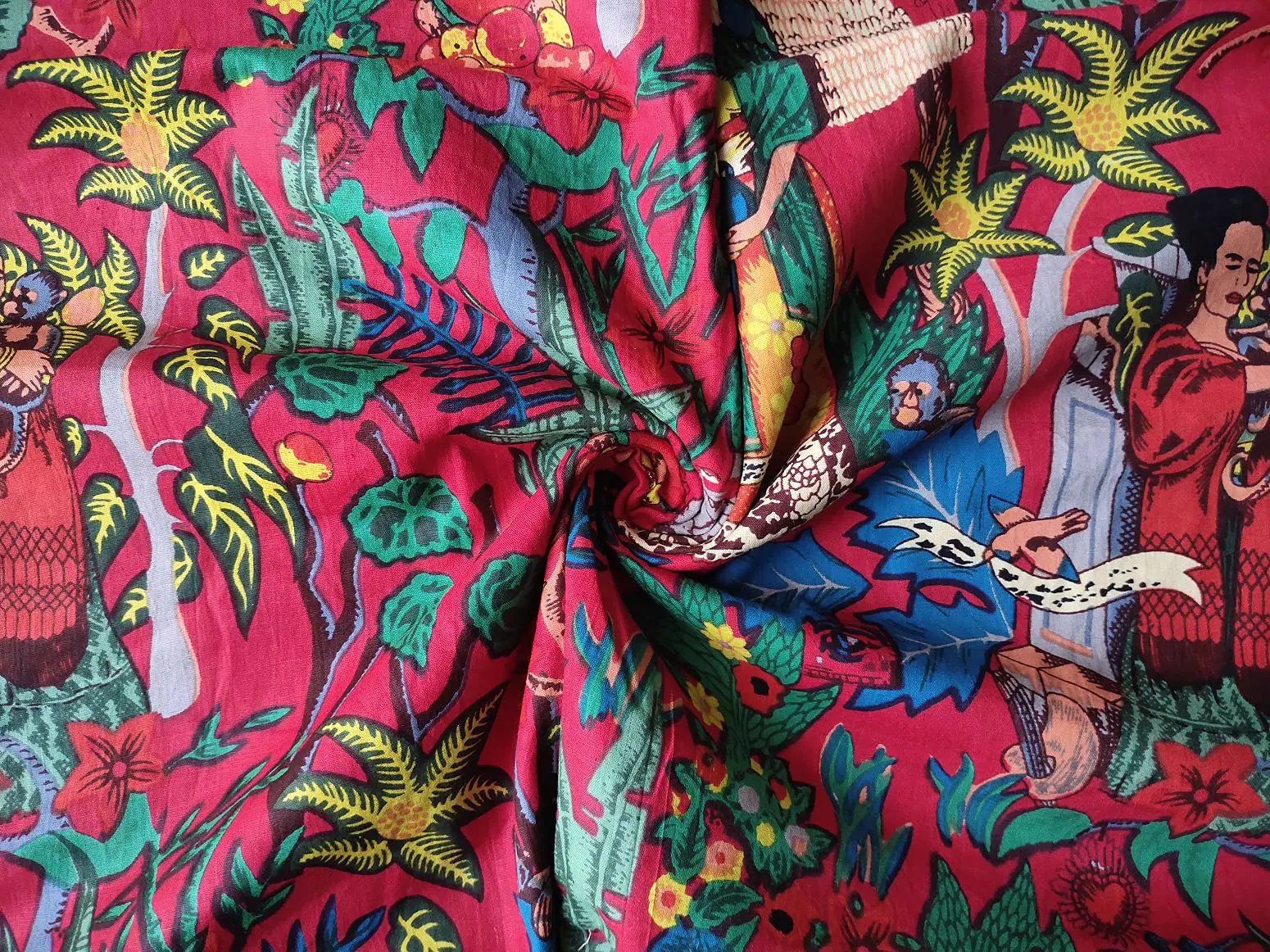
When it comes to hippie dresses, the choice of fabric is crucial in achieving the desired look and feel. The fabric should not only be comfortable to wear but also flowy and lightweight. In this article, we will explore the different types of fabrics that are commonly used in hippie dresses and their characteristics to help you make an informed decision.
- Cotton: Cotton is a popular choice for hippie dresses due to its breathability and softness. It is also very versatile and can be easily dyed in vibrant colors and patterns. Cotton dresses are perfect for warm weather as they help keep the body cool and absorb perspiration.
- Rayon: Rayon is another commonly used fabric in hippie dresses. It is derived from natural materials, making it eco-friendly. Rayon has a smooth texture and drapes beautifully, giving the dress a flowing and relaxed look. It is also breathable and lightweight, making it suitable for all-day wear.
- Linen: Linen is a natural fabric that is highly regarded for its breathability and ability to keep the body cool. It has a unique texture and a slightly wrinkled appearance, which adds to the bohemian vibe of a hippie dress. Linen dresses are perfect for summer as they allow air to circulate, preventing excessive sweat and discomfort.
- Silk: Silk is a luxurious fabric that exudes elegance and sophistication. While it may not be the most common fabric for hippie dresses, it can add a touch of glamour to any boho-inspired outfit. Silk dresses are lightweight, soft, and have a beautiful drape. However, they can be more expensive and require delicate care.
- Chiffon: Chiffon is a lightweight and sheer fabric that is commonly used in bohemian-style dresses. It has a delicate and ethereal appearance, perfect for creating a romantic and whimsical look. Chiffon dresses are often adorned with lace, embroidery, or other decorative details to enhance their feminine appeal.
- Batik: Batik is a traditional fabric printing technique that originated in Indonesia. It involves applying wax to the fabric and then dyeing it to create intricate designs and patterns. Batik dresses are unique and eye-catching, often featuring vibrant colors and geometric motifs. They are perfect for those who want to make a bold fashion statement.
To choose the right fabric for your hippie dress, consider the climate, occasion, and personal preferences. While cotton and rayon are more suitable for casual and everyday wear, silk and chiffon can elevate the dress for special occasions. Experiment with different fabrics and find the one that makes you feel comfortable and confident in your boho style. Remember, the fabric should reflect your free-spirited and individualistic personality.

Are there any specific patterns or designs that work well for a hippie dress?

Hippie dresses are known for their loose, flowing style and bohemian aesthetic. They often feature bold and vibrant patterns, as well as embroidery and fringe details. When it comes to choosing a pattern or design for a hippie dress, there are a few key factors to consider.
One of the most popular patterns for a hippie dress is the paisley print. Paisley is a teardrop-shaped motif that originated in Persia and became popular in the 1960s and 1970s during the hippie movement. It is characterized by intricate and swirling designs in a wide range of colors. Paisley prints can add a whimsical and bohemian touch to a hippie dress, and they are often used in combination with other patterns or as a standalone design.
Another popular pattern for a hippie dress is tie-dye. Tie-dye is a technique in which fabric is folded, twisted, or bunched together and then dyed with various colors to create unique and vibrant patterns. This technique was widely used by the hippie counterculture as a form of self-expression, and tie-dye is still closely associated with the hippie movement today. A tie-dye hippie dress can have a laid-back and free-spirited vibe, perfect for embracing the bohemian style.
In addition to patterns, hippie dresses often feature unique designs and details. Embroidery is a common embellishment found on hippie dresses, adding a touch of craftsmanship and intricacy. Flowers, birds, and other nature-inspired motifs are often embroidered onto the fabric, creating a whimsical and organic feel. Fringe is another popular detail that can be found on hippie dresses. Fringe adds movement and texture to the dress, giving it a dynamic and free-flowing look.
When it comes to choosing a specific pattern or design for a hippie dress, it ultimately comes down to personal preference and individual style. Some people may prefer bold and vibrant patterns, while others may prefer more subtle and earthy tones. It's important to find a pattern or design that resonates with you and makes you feel comfortable and confident.
To create your own hippie dress, you can follow these simple steps:
- Choose a fabric: Look for lightweight and flowy fabrics such as cotton or rayon. These fabrics will give your dress a relaxed and comfortable feel.
- Select a pattern or design: Decide on the pattern or design you want for your hippie dress. Consider options such as paisley prints, tie-dye, or solid colors with embroidered details.
- Take measurements: Take accurate measurements of your bust, waist, and hips to ensure a proper fit for your dress. Alternatively, you can use an existing dress as a template for your pattern.
- Create a pattern: Using your measurements, create a pattern for your dress on pattern paper or directly onto the fabric. Make sure to include seam allowances.
- Cut the fabric: Cut out the fabric according to your pattern, making sure to follow the grainline for proper drape.
- Sew the dress: Sew the dress together, following the instructions provided with your pattern or using your sewing skills. Make sure to reinforce seams and finish the edges to prevent fraying.
- Add details: Once the dress is sewn, you can add any additional details such as embroidery or fringe. These details can be hand-stitched or machine-stitched onto the fabric.
- Finish the dress: Hem the bottom of the dress and add any necessary closures, such as buttons or zippers.
By following these steps, you can create a personalized hippie dress that reflects your style and embraces the bohemian aesthetic. Remember to have fun with the process and let your creativity shine through.
The Ultimate Guide to Unwrinkle Dress Shoes: Tips and Tricks
You may want to see also

What are some techniques or sewing skills required to make a hippie dress?
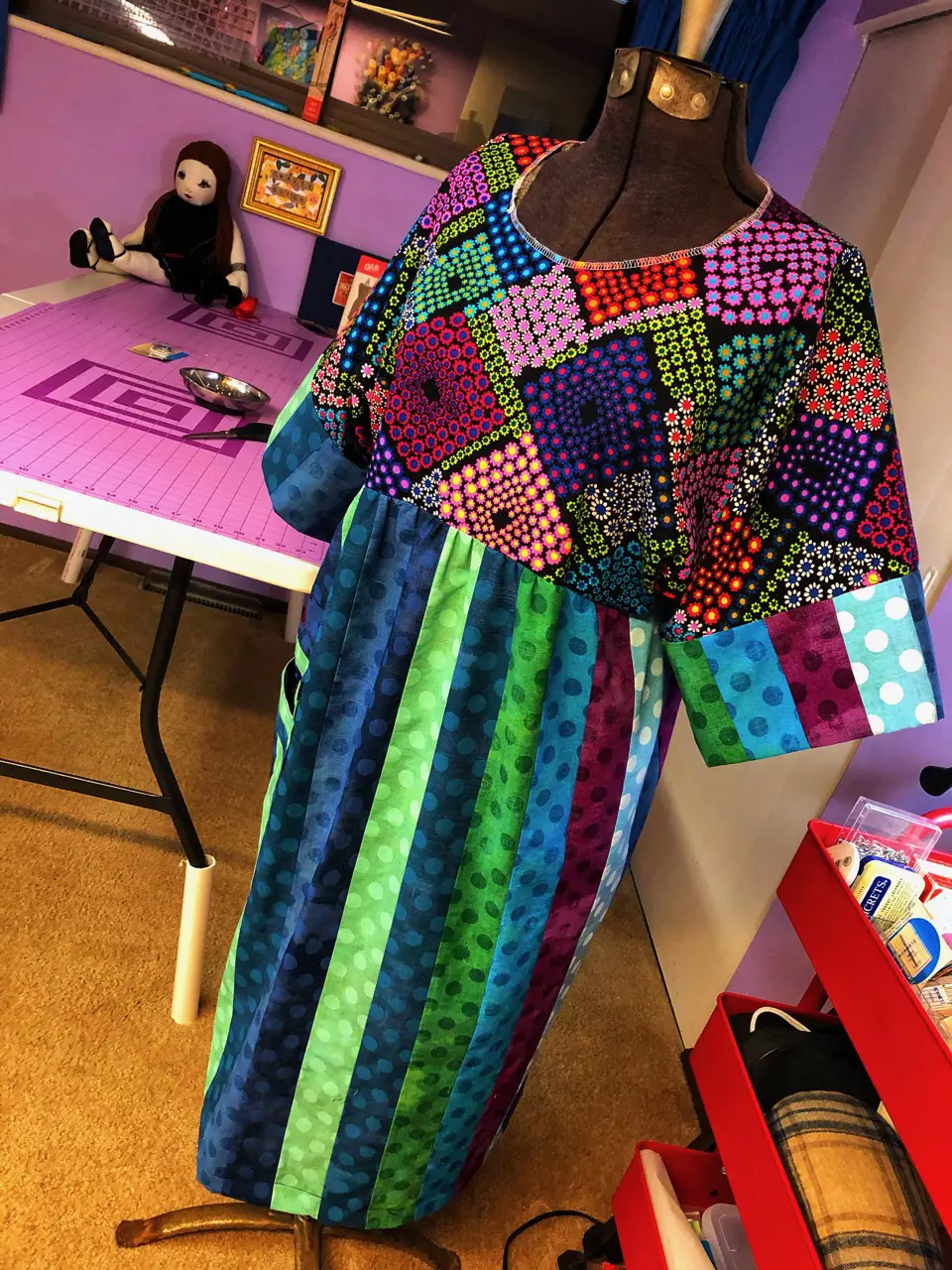
Hippie dresses are known for their bohemian and free-spirited style. If you're interested in making your own hippie dress, there are several techniques and sewing skills you will need to master. In this article, we will explore some of these techniques and skills in detail, providing you with a step-by-step guide and examples to help you create the perfect hippie dress.
Choosing the right fabric:
The first step in making a hippie dress is selecting the appropriate fabric. Choose lightweight and flowy fabrics such as chiffon, cotton, or rayon that will drape nicely on the body. Avoid heavy fabrics like denim or wool, as they can weigh down the dress and hinder its bohemian aesthetic.
Pattern selection and modification:
Once you have chosen your fabric, you will need to select a pattern that suits your style and body shape. Look for loose-fitting or empire waist patterns that allow for movement and comfort. You can also modify the pattern to add unique elements such as bell sleeves or a deep V-neckline to enhance the hippie vibe.
Cutting and sewing techniques:
When cutting the fabric, make sure to follow the pattern instructions accurately to ensure proper sizing and fit. Take your time when sewing the dress together, paying attention to details such as the seam finishes and hemming. Double-check your measurements and adjust as necessary to achieve the desired fit.
Embellishments and details:
To give your hippie dress an extra touch of boho charm, consider adding embellishments and details. This can be in the form of embroidery, lace trims, or tassels. You can also incorporate unique elements such as patchwork or tie-dye techniques to create a one-of-a-kind dress.
Understanding garment construction:
Having a good understanding of garment construction will greatly benefit your sewing skills. Learn how to properly attach facings, insert zippers, and create gathers or pleats. These techniques will help you achieve a polished and professional finish to your hippie dress.
Creating a comfortable fit:
Hippie dresses are often loose and flowing, allowing for freedom of movement. To ensure a comfortable fit, consider incorporating elastic or drawstrings at the waist or neckline. This will allow you to adjust the dress to your desired fit and make it easier to wear for extended periods.
Example: Let's say you have chosen a lightweight floral cotton fabric for your hippie dress. Following a loose-fitting pattern with a modified V-neckline and bell sleeves, you carefully cut the fabric according to the pattern instructions. As you sew the dress together, you use French seams for a clean and professional finish. To enhance the bohemian aesthetic, you add a delicate lace trim to the hemline and around the neckline. Finally, you attach a drawstring at the empire waist, allowing you to adjust the dress to your liking. The end result is a beautifully flowing hippie dress that is both comfortable and stylish.
In conclusion, creating a hippie dress requires a combination of techniques and sewing skills, such as choosing the right fabric, pattern selection and modification, cutting and sewing techniques, adding embellishments and details, understanding garment construction, and creating a comfortable fit. By mastering these skills and incorporating your own unique style, you can create a stunning hippie dress that reflects your individuality and love for bohemian fashion.
The Price Tag of an Ashi Studio Dress: Determining Fashion's Luxury Markup
You may want to see also

Can you provide a step-by-step guide on how to make a hippie dress from scratch?
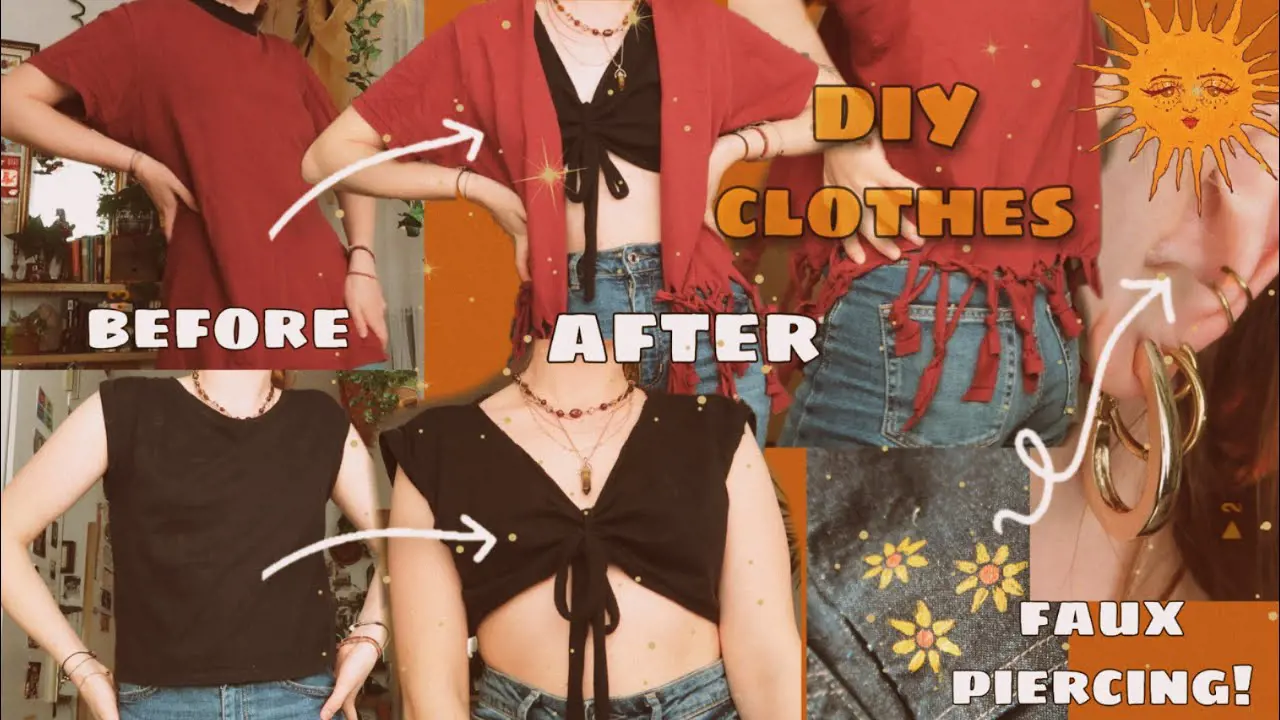
How to Make a Hippie Dress from Scratch: A Step-by-Step Guide
Hippie fashion is known for its vibrant colors, flowing silhouettes, and an overall feeling of freedom and individuality. Making a hippie dress from scratch allows you to embrace this unique style and customize it to your own taste. Whether you're an experienced seamstress or a beginner, follow this step-by-step guide to create your very own hippie dress.
Step 1: Choose the Fabric
Select a fabric that embodies the hippie aesthetic. Opt for organic and natural materials like cotton, linen, or rayon, as they provide a soft and comfortable feel. Look for fabrics with eye-catching prints such as paisley, floral, or tie-dye patterns. Remember, the fabric should be lightweight and drape nicely to achieve the flowy look that hippie dresses are known for.
Step 2: Take Accurate Measurements
Measure your body accurately to ensure a perfect fit for your dress. Take measurements of your bust, waist, hips, and the length you desire for the dress. Keep in mind that hippie dresses are typically loose-fitting, so consider adding ease to your measurements for a more relaxed fit.
Step 3: Draft a Pattern or Use a Commercial Pattern
If you have experience in drafting patterns, you can create one from scratch based on your measurements. Otherwise, you can use a commercial pattern as a starting point and modify it to fit your unique style. Many patterns are available online or in fabric stores specifically designed for bohemian or hippie dresses.
Step 4: Cut Out the Fabric
Using your pattern, carefully cut out the fabric pieces. Be sure to follow the guidelines provided by the pattern to ensure all necessary pieces are cut accurately. Take your time and cut slowly to achieve clean and precise edges.
Step 5: Sew the Bodice
Start by assembling the bodice pieces. Sew the front and back bodice panels together at the sides, right sides facing each other. If you want a more fitted bodice, you may consider adding darts at the bust area. Once the bodice is sewn, finish the raw edges with a serger or a zigzag stitch to prevent fraying.
Step 6: Create the Skirt
Next, sew the skirt pieces together, right sides facing each other. You can choose between a gathered or a pleated skirt depending on your desired style. Attach the skirt to the bodice, matching the waistline, and sew them together. Again, finish the raw edges to ensure durability and a clean finish.
Step 7: Add Finishing Touches
To give your hippie dress some personality, consider adding embellishments and details. Add lace trim to the hemline, create a bohemian-inspired tassel tie at the neckline, or sew on decorative patches or embroidery. These small details will enhance the hippie vibe of your dress and make it truly unique.
Step 8: Try on and Make Adjustments
Once your dress is complete, try it on and assess the fit. If any alterations need to be made, now is the time to do so. You may need to take in or let out seams, adjust the length, or make other minor modifications to ensure a perfect fit and comfortable wear.
Step 9: Wear and Enjoy
After making any necessary adjustments, your homemade hippie dress is ready to be worn and enjoyed. Embrace the free-spirited nature of hippie fashion as you step out in your unique creation. Pair it with sandals or boots, accessorize with funky jewelry, and let your inner bohemian shine.
Creating your own hippie dress from scratch not only allows you to express your individuality but also gives you a truly one-of-a-kind garment. With this step-by-step guide, you can confidently embark on your dressmaking journey and embrace the bohemian spirit in style. So gather your materials, unleash your creativity, and enjoy the process of making your very own hippie dress.
The Price Range of a Catherine Walker Coat Dress: What to Expect
You may want to see also
Frequently asked questions
If you don't have any sewing skills, you can still create a hippie dress by using fabric glue or safety pins. Look for a loose-fitting and flowy fabric, like tie-dye or floral print, and drape it over your body in a way that is comfortable and flattering. Use fabric glue to secure any loose edges or seams, or use safety pins to hold the fabric in place. You can also add embellishments like fringe or lace to customize your dress.
To make a hippie dress, you will need a few essential materials. Firstly, you will need fabric that is light and flowy, such as cotton or chiffon, in colors or prints that are reminiscent of the hippie era, like tie-dye or floral designs. You will also need basic sewing supplies, such as a sewing machine or needle and thread, scissors, and measuring tape. Additionally, you may want to gather any embellishments you desire, such as lace, fringe, or beads, to add a unique touch to your dress.
Absolutely! Upcycling old clothing is a great way to create a unique and sustainable hippie dress. Look for any old garments or fabrics you have that are no longer being used or worn. This could be an old maxi skirt, a thrifted dress, or even a sheet or curtain fabric. You can cut and sew these items to create your desired shape and style, adding any additional embellishments or details to make it more hippie-inspired. Upcycling not only saves money, but it also reduces waste and promotes a more eco-friendly approach to fashion.


